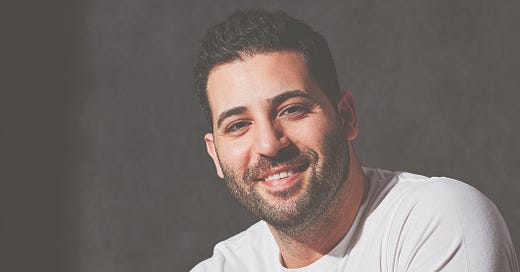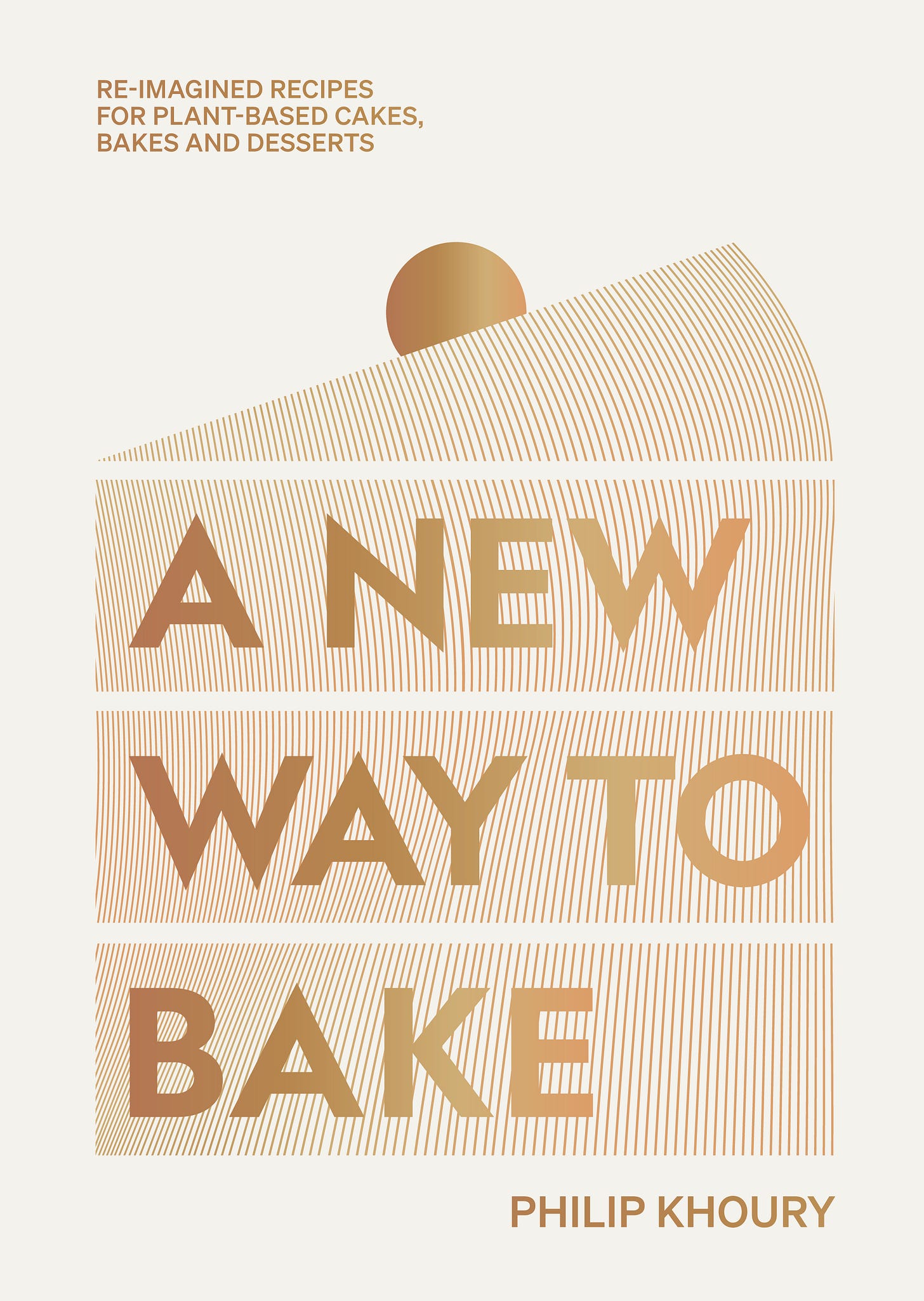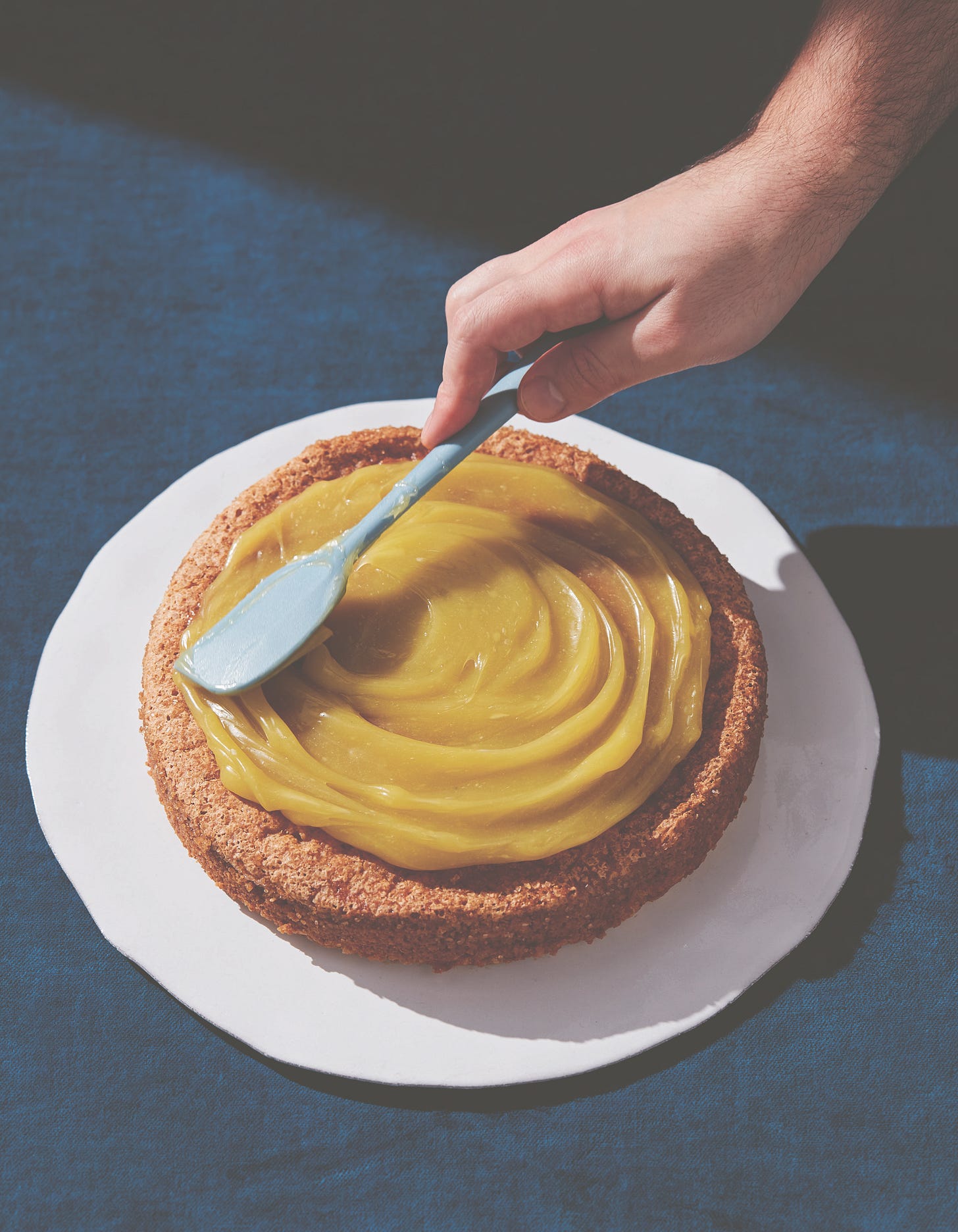Baking buds, hi! This is the latest profile of a regenerative baker. Have you peeped the pastry chef making desserts on top of glaciers? Or the chef restoring food sovereignty with sunflower cookies? No? Well, my god! Peep!
Philip Khoury may be a pastry wiz today, but he used to be just an earnest climate nut like the rest of us. As a teenager, the cookbook author and pastry chef at Harrod’s in London founded his high school’s environmental club. “I used to design stickers to hand out to all my friends that said ‘Stop climate change,’” he told me a couple Fridays ago, winning a permanent spot in this newsletter’s fan club in the process.
We were chatting at a big moment. The night prior, Philip had won the award for Debut Cookery Book at the Fortnum & Mason Awards in London for his cookbook A New Way to Bake: Re-Imagined Recipes for Plant-Based Cakes, Bakes, and Desserts. The cookbook is a serious addition to the vegan baking lexicon—a proof point that hallowed treats from babkas to Bakewell tarts can be made without animal products and their climate, health, and animal welfare impacts.
It wasn’t always clear to Philip that pastry chefs could do much about sustainability. But now he’s whisking the two passions together and helping make plant-based baking approachable by nixing the fancy stuff in favor of “plantry” ingredients.
As we talk about here often, carbon-intensive animal products like butter, eggs, and cream are the currency of the dessert world, which makes lower-carbon baking challenging. Eggs bind cakes together. Butter lends lemon curd silkiness. It’s rare to meet a mousse made without heavy cream or gelatin.
Despite the everywhereness of animal products in the pastry profession, their use eventually started to wear on Philip. “As a food professional, the closer you get to seeing where your food is made, the more concerned you become,” he says. He wondered: Could he make the case that dessert doesn’t always need dairy and eggs to be its tastiest self?
It was a big question without many obvious answers. He writes in A New Way to Bake that while pastry chefs have oodles of technical info at their disposal about traditional baking, “there’s no bible or handbook” for vegan baking. There’s just “some very old recipes crafted during times of religious fasting, and some completely new ones guided by a long history of learning about the functionalities of ingredients through trial and error.” So he decided to embark on some trial and error of his own.
He knew he was onto something when his boss and team at Harrod’s pastry kitchen approved two new desserts he’d developed—a raspberry-chocolate mousse and a tropical mousse surrounding a mango crema and a coconut financier—without knowing beforehand that they were vegan. When he told them, “everyone just kind of did a double take,” he says.
From there Philip turned his sights on things home bakers might want to make—apple pie, earl grey loaf cake, homemade caramels—and gave himself a rule for his emerging cookbook: All the ingredients had to be readily accessible.
That’s not always the case in vegan baking. Le Cordon Bleu Paris, for instance, taught me to make vegan ice cream with powdered glucose and carob gum. Two things I do not stock today, for the record. Eleven Madison Park in Manhattan reportedly used a blend of four plant-based butters to give the croissants at their plant-based pop-up Bake It Nice sufficient flake. Which, again—cool, but not something most people can pull off at home.
Philip found that it was possible to create convincing facsimiles of dairyful recipes with everyday “plantry” ingredients (think: coconut milk, olive oil, sweet potato), if he gave classic recipe formulas a serious makeover. A classic pound cake, for instance, is typically made with equal parts flour, butter, sugar, and eggs. But that 1:1:1:1 formula only requires as much fat as it does, Philip explains, “to offset the gelling effect that all the egg and flour has. So when you don’t have the egg you actually need to use less fat.” (Chemistry, baby.)
He also found, in the course of his recipe development, a deeper appreciation for ingredients that are sometimes cast into milk and butter’s shadow. Soy milk, he points out, has such high protein content that it helps stuff form stable emulsions, as in his vegan whipped cream. Olive oil, he adds, makes cakes moister than butter while using less of it, because “it has a more penetrative effect in a bake.” The fact of using a smaller amount of oil than you would if you were using butter means that even a strong-flavored olive oil typically blends in with flavors like chocolate just fine. On the flip side, olive oil can also be a star. It’s an earthy-sunshiney showstopper in the cake recipe below and the improbably creamy curd that tops it.
Philip hopes A New Way to Bake is just the start. He’s thinking about savory recipes for home bakers, maybe some vegan candies and chocolates at Harrod’s—basically: more, more, more, so that he can keep pushing the boundaries of plant-based baking. “Whether you care about the environment, animal cruelty, or health,” he says, “there's just so many reasons that we should look at more options. I always say that A New Way to Bake is not the best way. It's not the only way. It's just more ways.”
Philip’s recipe for Extra Virgin Olive Oil Cake
Philip’s recipe note: In so many recipes of mine where I use extra virgin olive oil, it doesn’t contribute a lot of flavour because not much is used, but in this recipe I wanted to celebrate its beautiful distinctive flavour. For the olive oil cream we are making an emulsion – the fancy word for blending and holding oil and water together in the silkiest cream ever known to the gods.
Makes a 23 cm (9 in) cake
Olive oil cake batter
120g apples, cored and chopped into 2 cm (3⁄4 in) pieces
28g lemon juice
60g mandarin, peeled (*orange or clementine works)
1 lemon zest, grated
1 mandarin zest, grated
240g soy milk
100g extra virgin olive oil
6 rosemary leaves
220g caster (superfine) sugar
250g plain (all-purpose) flour
8g baking powder
4g bicarbonate of soda (baking soda)
1g salt
Demerara sugar, for sprinkling
Preheat the oven to 180°C fan (350°F/gas 4) with an oven shelf in the middle of the oven. Line the base of a 23 cm (9 in) cake tin (pan) with baking parchment.
Blend the chopped apple, lemon juice, mandarin segments, lemon zest, mandarin zest, soy milk, olive oil and rosemary leaves in a blender until smooth. You
can also use an immersion stick blender in a large bowl.
Whisk the caster sugar, plain flour, baking powder, bicarbonate of soda and salt together in a large bowl.
Add the blended liquids to the dry ingredients and mix until mix well combined.
Pour the batter into the prepared tin. Sprinkle Demerara sugar over the top and bake for 30 minutes, or until golden and the top springs back when pressed with your fingertips.
Leave to cool completely on a wire rack, then remove from the tin.
Olive oil curd
40g soy milk
80g caster (superfine) sugar
60g extra virgin olive oil
10g lemon juice
Pour the soy milk into a small blending jug or in a microwave bowl and microwave for 20 seconds, or until lukewarm. Alternatively, warm the milk in a small saucepan over a low heat. Add the sugar and olive oil and use a hand-held blender to blend until it is silky, thick and creamy.
Spread it on top of the cooled cake with a palette knife. This cake keeps very well in an airtight container at room temperature for 3–4 days.








Incredible! Will have to check out the book
Beyond excited to try this recipe and get this cookbook! Thank you so much for sharing this. Did I miss it or does he recommend a light or more flavorful extra virgin olive oil?